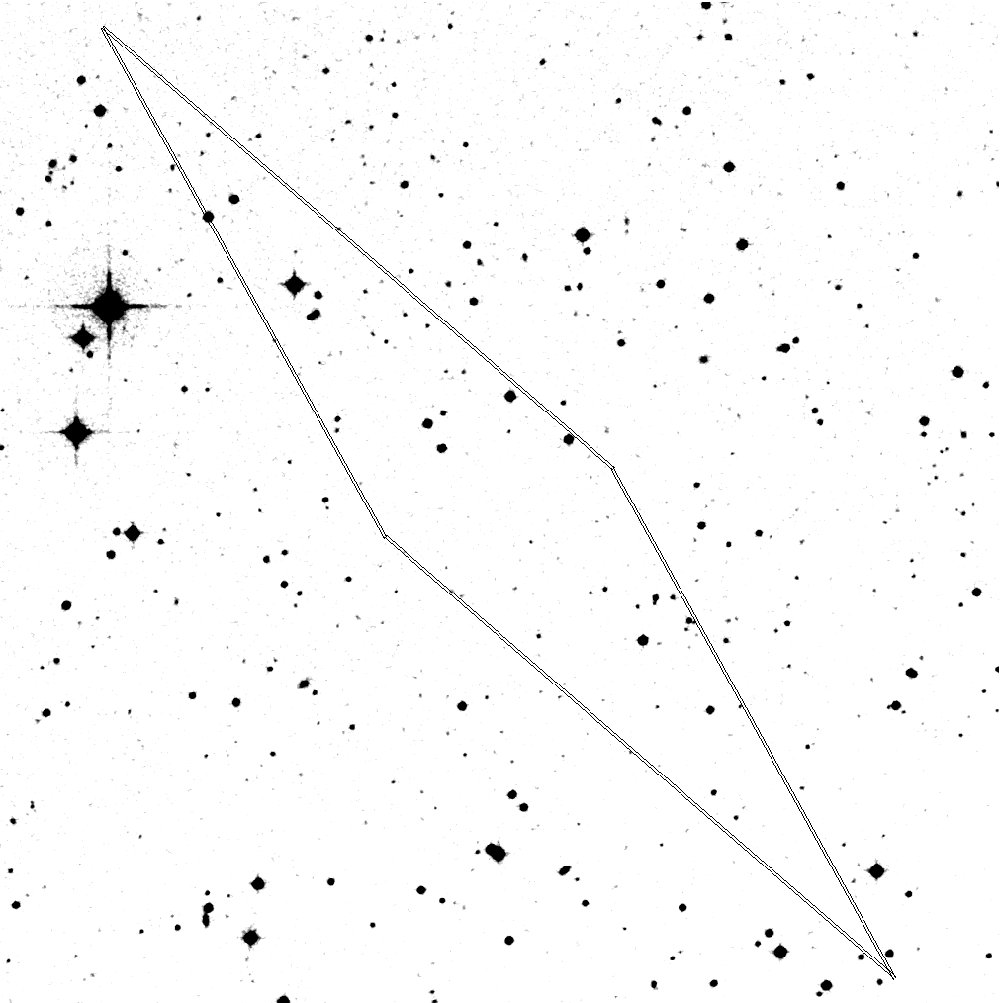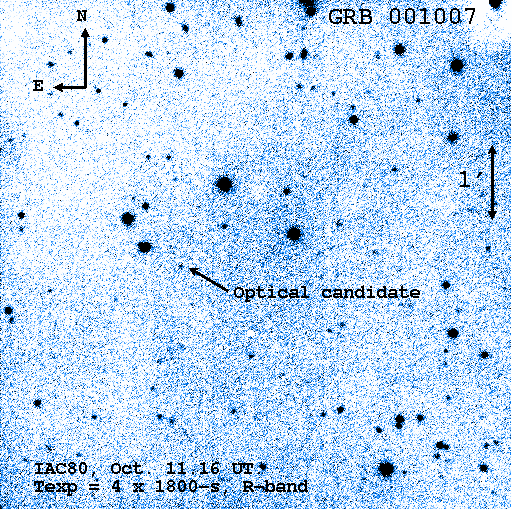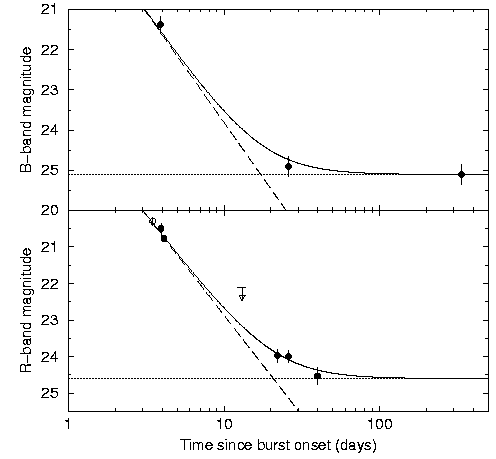
Gamma-ray Burst 001007

(All information courtesy of the instrument teams.)
 Previous IAU Circulars
Previous IAU Circulars
 Results of Observations
Results of Observations
- GCN notice #841
K. Hurley, on behalf of the Ulysses GRB team, T. Cline, on behalf
of the Konus-Wind and NEAR GRB teams, and E. Mazets and S. Golenetskii,
on behalf of the Konus-Wind GRB team, report:
Ulysses, Konus-Wind, and NEAR observed this burst at 17927 s. As
observed by Ulysses, it had a duration of approx. 375 seconds,
a 25-100 keV fluence of approx. 3.3E-05 erg/cm2, and a peak flux
over 0.5 s of 7.1E-07 erg/cm2 s. We have triangulated it to
a preliminary, 3 sigma error box whose area is approx. 40
sq. arcmin. and whose coordinates are:
RA(2000) DEC(2000)
4 h 5 m 52.26 s -21 o 54 ' 22.76 " (CENTER)
4 h 5 m 43.95 s -21 o 53 ' 46.46 " (CORNER)
4 h 6 m 21.73 s -21 o 46 ' 23.26 " (CORNER)
4 h 5 m 22.81 s -22 o 2 ' 21.58 " (CORNER)
4 h 6 m 0.58 s -21 o 54 ' 59.04 " (CORNER)
This error box may be improved.
- red DSS2 finding chart
ps-file

- GCN notice #843
P.A. Price, T.S. Axelrod and B.P. Schmidt (RSAA, ANU) report:
We have observed the error box of the long, bright GRB001007
(Hurley et. al., GCN #841) with the robotic 50-inch telescope at
Mount Stromlo Observatory with 3 x 300s exposures starting at
Oct 10.69 (approximately 3.5 days after the burst). Our images
in R_MACHO and B_MACHO cover the entire error box.
We detect one object at the centre of the error box for which a
counterpart is not visible on the Digital Sky Survey 2. The
object is well detected in the MACHO-red frame, and faintly detected
in the MACHO-blue frame. This object is located at J2000 coordinates:
RA: 04:05:54.29
Dec: -21:53:45.5
Using the star at 04:05:56.44 -21:52:52.96 with assumed R=17.7
(USNO catalogue), the object has R ~ 20.3 mag.
No other candidates are detected within the error box.
We note that this magnitude may be near the plate limit of the DSS-2,
and that an afterglow with this brightness this late after the
burst is unusual. Further observations are required to
verify if this is the optical transient associated with GRB001007.
- GCN notice #845
Alberto J. Castro-Tirado, LAEFF-INTA (Madrid) and IAA-CSIC (Granada),
Yves Grosdidier, IAC (Tenerife),
Jose Maria Castro Ceron, ROA (San Fernando),
Javier Gorosabel, DSRI (Copenhagen),
Nicola Caon, IAC (Tenerife),
Luz Marina Cairos, IAC (Tenerife),
on behalf of a larger European GRB collaboration
report:
We have obtained BVR-band images of a 7' x 7' area centred at
the GRB 001007 error box (Hurley et al. GCN#841) starting at
03:45 UT on 11 October 2000 with the 0.8m IAC80 telescope at the
Spanish Observatorio del Teide.
The candidate reported by Price et al. (GCN #843) is clearly
detected in the the co-added 4 x 1800-s R-band image. We note
that this object is not present at the DSS-2 red plate limit
(about R = 21). No other new or variable sources are seen in the
frame. The object is also detected in the single 1800-s V-band
image, but not in the co-added 2 x 1800-s B-band frames. Using
the USNO star quoted in GCN#843, we measure R = 20.28 +/- 0.13
(aperture photometry). This suggests that this source did not fade
during the 12 hours elapsed between our exposures and those taken at
Mount Stromlo. If this is the GRB optical counterpart, this might
resemble the behaviour of GRB 970508 at early epochs (Pedersen et
al. 1998, ApJ 496, 311, Castro-Tirado et al. 1998, Sci 279, 1011).
An identification chart is posted at:
http://www.dsri.dk/~jgu/grb001007/iac80/1007.iac80.gif
and reproduced below:

- GCN notice #860
D. A. Frail (NRAO) and E. Berger (Caltech) report on behalf of a
larger collaboration:
We used the VLA to observe a field centered at the position of the
optical object identified by Price, Axelrod and Schmidt (GCN #843) in
the IPN error box of GRB 001007 (GCN #841). Our images, taken on 2000
October 14.28 UT and October 21.43 UT, show an unresolved radio source
coincident with the optical source. We measure 8.46 GHz flux densities
on these two days of 222 +/- 33 uJy and 101 +/- 28 uJy, respectively.
The optical (GCN #843, #845) and radio properties of this object make
it a strong candidate for an afterglow. Further observations are
planned.
- GCN notice #862
P.A. Price (Caltech), O. Pevunova, B. Madore (IPAC) and S.G. Djorgovski
(Caltech) report on behalf of a larger collaboration:
We have observed the afterglow candidate of GRB001007 (Price et al.,
GCN #843, Frail & Berger, GCN #860) with the Palomar 60-inch telescope
with 4x900s exposures starting at Oct 25.34 UT. We do not detect
the candidate to a limiting magnitude of R = 21.6 (based on the
reference star from GCN #843, for 50% automated detection of artificial
stars in the field). The derived temporal decay slope between our two
epochs (Oct 10.69 and Oct 25.34) is alpha > 1.9 .
- Optical light curve from Castro Ceron et al (astro-ph/0110048)

Back to JG's
homepage
Jochen Greiner, last update: 8-Oct-2001
[Disclaimer]
![]() Previous IAU Circulars
Previous IAU Circulars 

